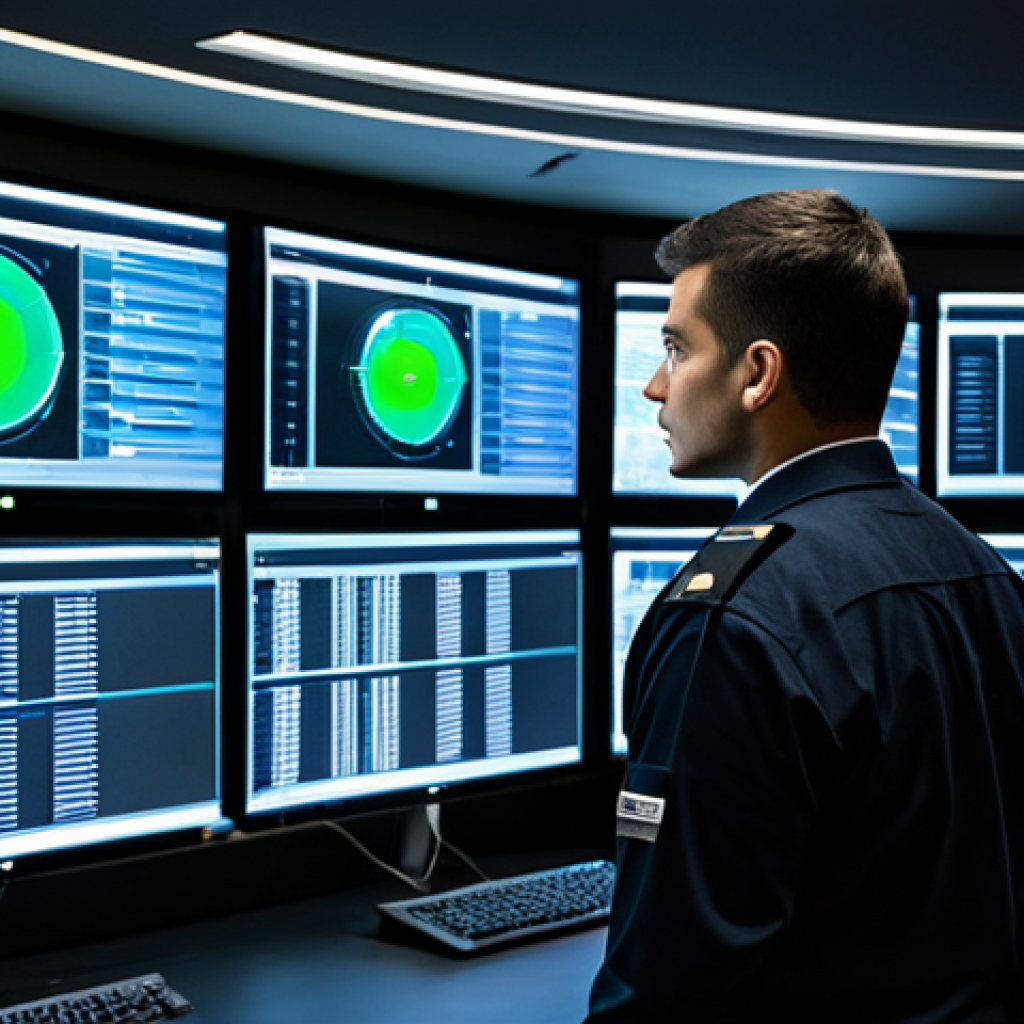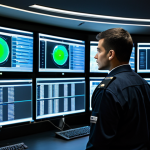Stepping onto the job as a security guard, I honestly thought it would be a straightforward gig – watching screens, patrolling halls. But boy, was I wrong.
My time on the beat, whether it was late-night shifts guarding commercial properties or ensuring event safety, taught me lessons that go far beyond just keeping an eye out.
It’s about human psychology, anticipation, and the subtle art of de-escalation. I’ve personally seen how the quiet moments often hide the most crucial observations, shaping not just how I view safety, but life itself.
What truly struck me wasn’t just the visible threats, but the unseen ones – the vulnerabilities that technology is both creating and solving. In today’s hyper-connected world, with smart homes becoming standard and businesses relying heavily on digital infrastructure, the role of security is radically shifting.
We’re seeing a massive surge in AI-powered surveillance, predictive analytics trying to flag risks before they even materialize, and remote monitoring becoming incredibly sophisticated.
I often found myself reflecting on how these new tools would have impacted situations I handled, wondering if they’d truly enhance or complicate the human element of security.
Despite the rapid advancements, my on-the-ground experience solidified one undeniable truth: human intuition, empathy, and adaptability remain paramount.
No algorithm can truly replicate the nuanced judgment required when dealing with a tense situation, or the subtle body language cues that scream ‘something’s off.’ Looking ahead, I predict a fascinating blend: security personnel will increasingly become ‘tech-enabled guardians,’ leveraging AI and data insights while their core value will be in their soft skills – communication, crisis management, and that irreplaceable human touch.
The future of security isn’t just about bigger cameras or faster drones; it’s about smart, empathetic people working *with* smart systems to create truly resilient environments.
From the potential rise of ‘sentient’ AI patrolling virtual spaces to the increasing demand for specialized cybersecurity guards protecting our digital assets, the landscape is evolving at a breakneck pace.
This evolving dynamic presents both challenges and incredible opportunities for those in the field, and it’s something I’m constantly analyzing. Let’s delve into the specifics of these transformations and what they truly mean for our safety and the future of security.
The Evolving Landscape of Digital and Physical Safeguards

The security world, as I’ve come to understand it, is no longer just about visible barriers or the vigilant eye of a guard. It’s a complex tapestry where digital vulnerabilities intertwine with physical threats, creating an ever-shifting challenge that truly keeps you on your toes.
What I’ve personally seen, especially over the last few years, is a remarkable acceleration in how we perceive and combat these dangers. From the quiet hum of server rooms to the bustling energy of public spaces, the definition of ‘secure’ is constantly being redefined.
It’s not just about reacting to incidents anymore; it’s about anticipating, preventing, and building resilience in ways we never imagined possible a decade ago.
I often reflect on incidents where a more integrated, tech-forward approach could have shifted the outcome, moving from a reactive scramble to a proactive, controlled response.
This shift demands a holistic understanding, something I’ve learned invaluable lessons about on the ground.
1. Redefining the Perimeter: From Walls to Wireless Signals
When I first started, the perimeter was clearly defined: a fence, a wall, a door. Today, that concept feels almost quaint. Our digital footprints are the new open windows, and every smart device, every network connection, is a potential doorway for those with malicious intent.
I’ve seen businesses, large and small, grapple with this expanded frontier, realizing that a robust physical security system is meaningless if their digital assets are compromised.
Think about a smart home – every connected appliance, from your doorbell to your thermostat, becomes a potential entry point for data theft or even physical access if exploited.
The sheer volume of data being generated, from surveillance cameras to IoT sensors, creates a vast new attack surface, and protecting it is far more intricate than simply locking a gate.
What truly keeps me up at night is the thought of how interconnected our lives are becoming, and with that convenience comes an inherent vulnerability that many are not fully prepared to manage.
It’s a constant race to understand and fortify these invisible walls that now protect our most valuable information and privacy.
2. The Unseen Human Element in Cybersecurity
While we talk a lot about sophisticated malware and advanced persistent threats, my experience has consistently shown that the weakest link often isn’t the technology, but the human using it.
Phishing scams, social engineering, and plain old human error remain incredibly effective ways for attackers to breach even the most fortified digital defenses.
I’ve witnessed firsthand how a momentary lapse in judgment or a lack of awareness can lead to significant data breaches or system failures. Training and cultivating a security-conscious culture is, in my opinion, just as vital as deploying the latest firewalls.
It’s about empowering every individual, from the CEO to the front-desk staff, to be an active participant in maintaining security. You can have the most advanced security protocols in place, but if someone clicks on a suspicious link or shares sensitive information unknowingly, the entire system can be compromised.
This highlights an often-overlooked aspect of security: the psychological battle waged daily against human fallibility and curiosity. It requires continuous education and a deep understanding of human behavior to truly fortify an organization against these ubiquitous threats.
Leveraging AI and Data for Proactive Security Measures
The advancements in artificial intelligence and machine learning have been nothing short of revolutionary for the security sector. What once felt like science fiction is now becoming standard practice, transforming how we detect, respond to, and even predict potential threats.
From my perspective, these tools aren’t replacing human guards but are rather becoming indispensable partners, extending our capabilities beyond what a human eye or ear could ever achieve alone.
I’ve seen demos of AI systems that can sift through hours of surveillance footage in minutes, highlighting anomalies that a human might miss even after multiple viewings.
This shift towards proactive, data-driven security is exciting, but it also brings its own set of complexities and ethical considerations that we must navigate carefully.
It’s about finding that sweet spot where technology empowers us without eroding fundamental rights or generating undue surveillance.
1. Predictive Analytics and Anomaly Detection: A New Era of Vigilance
Imagine a system that learns the ‘normal’ patterns of a building or a network, from foot traffic flows to network activity spikes. Now, imagine that system instantly flagging anything that deviates from that norm – a door opening at an unusual hour, a server accessing an unusual IP address, or even a vehicle loitering too long in a restricted area.
This is the power of predictive analytics and anomaly detection. It moves us away from purely reactive security where we wait for an incident to occur, towards a proactive stance where we can intervene before a situation escalates.
I’ve often thought back to situations I handled, wondering how much smoother they would have gone if I had received an AI-generated alert minutes, or even seconds, before things went south.
These systems are constantly learning and refining their understanding of ‘normal,’ making them increasingly effective at spotting the subtle indicators of trouble brewing.
It’s a game-changer, allowing us to deploy resources more efficiently and focus our human attention on genuine threats rather than endless monitoring.
2. The Promise and Peril of Automated Surveillance
Automated surveillance systems, especially those powered by AI for facial recognition and object detection, offer incredible efficiency. They can track individuals or vehicles across multiple cameras, identify potential intruders, and even recognize specific behaviors that might indicate a threat.
On the ground, this means quicker response times and a higher likelihood of identifying culprits. However, this power comes with a significant ethical weight.
The privacy implications are immense. My concern, and one I’ve discussed with peers, is ensuring these powerful tools are used responsibly and ethically, with clear guidelines and oversight.
We need to strike a delicate balance between enhancing public safety and safeguarding individual liberties. It’s not enough to simply deploy the technology; we must also establish robust frameworks for its use, ensuring transparency and accountability at every step.
Without these safeguards, the very tools designed to protect us could inadvertently erode the freedoms we cherish.
The Indispensable Human Element in a Tech-Driven World
Despite the dazzling advancements in AI and automation, I firmly believe that the human element remains the cornerstone of effective security. Technology enhances our capabilities, but it can never fully replicate the nuances of human judgment, empathy, and adaptability.
In my years on the beat, I’ve encountered countless situations where a rigid protocol or an algorithm would have failed, but human intuition, a calm demeanor, or a well-placed question diffused a potential crisis.
This isn’t just about identifying a threat; it’s about understanding the context, reading subtle body language, and making decisions in real-time under pressure – skills that are inherently human.
1. Emotional Intelligence and De-escalation: Skills No Algorithm Can Replicate
I’ve learned that often, the most effective security measure isn’t a weapon or a camera, but a conversation. The ability to de-escalate a tense situation, to read emotions, and to communicate effectively is paramount.
I recall one incident where a distraught individual was causing a disturbance; no amount of shouting or force would have helped. It was a quiet conversation, a listening ear, and a calm presence that ultimately resolved the situation peacefully.
An AI might flag the disturbance, but it can’t offer empathy or navigate the complex emotional landscape of human interaction. These soft skills, often undervalued, are what truly define a capable security professional.
They are about understanding human psychology, predicting reactions, and guiding outcomes through communication rather than confrontation. This personal touch is irreplaceable, especially when dealing with sensitive or volatile situations.
2. Adapting to the Unforeseen: Human Ingenuity in Crisis
No two security incidents are exactly alike, and unexpected variables always emerge. This is where human adaptability and improvisation become critical.
While AI can analyze vast datasets and follow predetermined protocols, it struggles with truly novel situations that fall outside its trained parameters.
I’ve had to make split-second decisions based on incomplete information, drawing on experience and instinct to navigate chaos. These moments, where quick thinking and creative problem-solving are required, are the true test of a security professional.
A machine might identify a broken window, but it won’t notice the strange vehicle idling down the street, or the subtle shift in a person’s posture that suggests impending aggression.
It’s this capacity for holistic, intuitive understanding and the ability to think on one’s feet that separates a good security system from a truly resilient one.
We are the ultimate fail-safe, the improvisers when the script goes awry.
Navigating the Ethical Minefield of Advanced Surveillance
The rapid evolution of security technologies, particularly those involving advanced surveillance, has opened up a significant ethical dialogue. While these tools promise enhanced safety and efficiency, they also raise profound questions about privacy, civil liberties, and the potential for misuse.
From my vantage point, having been on both sides of the surveillance lens – as an operator and as a citizen subject to it – these aren’t just theoretical discussions.
They are real, tangible concerns that impact individuals and communities daily. We are at a critical juncture where the decisions we make about how to deploy and regulate these technologies will shape the very fabric of our society.
1. Balancing Privacy Rights with Public Safety Needs
This is, perhaps, the most contentious issue in modern security. Every new camera, every facial recognition deployment, every data point collected, brings us closer to a surveillance state if not managed with extreme care.
While I understand the need for tools that enhance public safety and aid law enforcement, I’m also acutely aware of the potential for overreach. Who has access to this data?
How long is it stored? What are the safeguards against misuse? These are not trivial questions.
I’ve personally felt the discomfort of knowing that every move might be recorded and analyzed, even when I have nothing to hide. A truly secure society isn’t one where everyone is constantly watched, but one where trust is maintained through transparent and accountable use of technology.
This requires ongoing public discourse, robust legal frameworks, and ethical guidelines that prioritize individual rights alongside collective security.
Without these checks and balances, we risk sacrificing fundamental freedoms for a false sense of security.
2. Avoiding Algorithmic Bias and Discrimination
One of the most alarming ethical challenges is the potential for algorithmic bias. If AI systems are trained on biased data, they can perpetuate or even amplify existing societal prejudices.
For instance, facial recognition systems have historically shown higher error rates for certain demographics, leading to potential misidentifications and disproportionate surveillance.
This is a critical concern for anyone committed to fair and equitable security practices. As security professionals, we have a moral obligation to ensure that the tools we employ do not inadvertently discriminate or target individuals based on their race, gender, or any other characteristic.
It requires constant auditing of algorithms, diverse data sets for training, and a deep understanding of the societal implications of our technological choices.
My personal stance is that if a technology cannot be proven free from harmful bias, its deployment must be approached with extreme caution, if at all.
The pursuit of safety must never come at the cost of justice.
Training the Next Generation of Tech-Enabled Guardians
The rapid evolution of the security landscape means that the skills required for security professionals are also shifting dramatically. The traditional image of a guard as simply a physical deterrent is long gone.
Today’s security experts need a blend of traditional safety acumen, technological proficiency, and advanced soft skills. This presents a significant challenge for training programs, which must adapt quickly to produce a workforce capable of navigating the complexities of modern threats.
As someone who has lived through this transformation, I see an urgent need to redefine what it means to be a “guardian” in the 21st century. It’s about becoming fluent in both human dynamics and digital infrastructure.
1. Bridging the Gap: Integrating Tech Proficiency with Traditional Skills
The next generation of security personnel must be conversant in everything from cybersecurity basics to operating advanced surveillance systems. It’s no longer enough to just know how to patrol a perimeter; they need to understand network vulnerabilities, data encryption, and forensic analysis.
This requires a curriculum that blends traditional security training – first aid, conflict resolution, physical deterrence – with intensive tech education.
I envision training modules that simulate real-world cyber-attacks alongside physical breaches, forcing trainees to think critically across both domains.
The goal is to create professionals who can seamlessly transition between securing a physical location and protecting its digital twin. This means less time in purely theoretical classes and more hands-on experience with the actual tools and challenges they will encounter.
2. Cultivating Critical Thinking and Adaptability in Training
Beyond specific skills, the most valuable traits for future security professionals will be critical thinking, problem-solving, and adaptability. As I mentioned, no two situations are identical, and technology can only take us so far.
Training must emphasize scenario-based learning that encourages independent thought and creative solutions to unforeseen problems. This means moving away from rote memorization and towards dynamic simulations that force trainees to analyze complex situations, make quick decisions under pressure, and adjust their strategies on the fly.
It’s about fostering a mindset of continuous learning and evolution, preparing individuals not just for today’s threats but for the threats of tomorrow that we haven’t even conceived of yet.
The ability to learn, unlearn, and relearn will be their most potent weapon.
| Aspect | Traditional Security Approaches | Modern Tech-Enabled Security Approaches |
|---|---|---|
| Primary Focus | Physical deterrence, reactive response, human patrols, fixed cameras. | Proactive threat prediction, data analytics, integrated digital & physical protection. |
| Key Tools | Locks, alarms, fences, guard patrols, basic CCTV, radios. | AI-powered surveillance, IoT sensors, predictive analytics, cybersecurity software, drones, biometric access. |
| Threat Perception | Visible intruders, physical theft, vandalism, on-site disturbances. | Cyber attacks, data breaches, insider threats, invisible digital vulnerabilities, physical anomalies detected by AI. |
| Response Time | Dependent on human observation & physical presence. | Real-time alerts, automated responses, faster human deployment based on data insights. |
| Cost Implications | Primarily labor-intensive, some equipment costs. | Higher initial tech investment, but potentially lower long-term operational costs due to automation & efficiency. |
| Skill Set Required | Physical strength, observation, communication, basic first aid, conflict resolution. | Technical proficiency (IT, network security), data analysis, advanced de-escalation, ethical considerations. |
The Economic Implications of Next-Gen Security Solutions
The shift towards advanced security technologies is not just about improved safety; it also carries significant economic implications for businesses, governments, and individuals.
Investing in cutting-edge security solutions can be a substantial undertaking, but the potential returns, both in terms of loss prevention and operational efficiency, are increasingly compelling.
From my perspective, honed by years of seeing budgets allocated and resources deployed, it’s clear that organizations are beginning to view security not just as a cost center, but as a strategic investment.
This includes everything from the upfront capital expenditure to the ongoing operational costs and the potential for new revenue streams within the security industry itself.
1. Cost-Benefit Analysis: The ROI of Advanced Security
While traditional security often felt like a necessary expense, modern, tech-enabled security is increasingly demonstrating a clear return on investment (ROI).
Consider the financial fallout of a major data breach – regulatory fines, reputational damage, lost customer trust, and recovery costs can easily run into millions, or even billions.
Investing in robust cybersecurity, AI-powered threat detection, and advanced physical security can prevent these catastrophic losses. I’ve personally seen how a well-placed, AI-monitored camera system prevented a costly theft, or how strong network security saved a company from a devastating ransomware attack.
It’s about more than just preventing incidents; it’s about safeguarding continuity, protecting intellectual property, and maintaining market confidence.
The upfront cost of sophisticated systems might seem high, but when weighed against the potential cost of inaction, the value becomes undeniable.
2. The Rise of a Specialized Security Economy
The evolution of security also fuels a burgeoning economy built around specialized services and technologies. We’re seeing a significant demand for cybersecurity analysts, AI integration specialists, data privacy officers, and even “ethical hackers” who test vulnerabilities.
This creates new job markets and opportunities for innovation. Furthermore, the development of bespoke security solutions for industries like smart cities, critical infrastructure, and autonomous vehicles represents massive growth potential.
As threats become more sophisticated, so too does the need for highly specialized security products and services, ranging from custom software to advanced hardware and consulting.
This dynamic creates a robust ecosystem where innovation is constantly driven by the evolving threat landscape, leading to a perpetual cycle of technological advancement and economic opportunity within the security sector.
Closing Thoughts
The journey through the security landscape, from simple locks to AI-powered surveillance, truly highlights how dynamic this field has become. What I’ve consistently observed is that while technology provides unprecedented capabilities, the core of effective security will always lie in human judgment, empathy, and ethical stewardship. As we continue to integrate more sophisticated solutions into our lives and businesses, remember that genuine safety isn’t just about what we can protect, but how wisely and responsibly we choose to protect it. It’s an ongoing conversation, a continuous adaptation, and a shared responsibility that shapes our increasingly interconnected world.
Useful Information
1. Assess Your Digital Footprint: Regularly review your online privacy settings, use strong, unique passwords for all accounts, and enable two-factor authentication wherever possible. Your digital life is as vulnerable as your front door.
2. Stay Informed on Scams: Cybercriminals constantly evolve their tactics. Educate yourself and your family about common phishing techniques, social engineering attempts, and emerging online threats to avoid becoming a victim.
3. Consider Integrated Solutions: For businesses or even smart homes, look beyond isolated physical or digital security. Seek out solutions that integrate both aspects, offering a holistic defense against diverse threats.
4. Question the ‘Black Box’: When evaluating AI-powered security, ask about data privacy protocols, bias mitigation strategies, and human oversight. Transparency is key to ensuring these powerful tools are used ethically.
5. Invest in Training: Whether for personal awareness or organizational security, continuous education is paramount. A well-informed individual or team is your strongest defense against both human error and sophisticated attacks.
Key Takeaways
The security landscape is rapidly evolving, demanding an integrated approach that merges advanced technology with indispensable human skills. Digital and physical perimeters are converging, making comprehensive protection vital. While AI and data analytics offer powerful tools for proactive threat detection and enhanced vigilance, they also necessitate careful ethical consideration, particularly regarding privacy and algorithmic bias. Ultimately, human elements like emotional intelligence, adaptability, and critical thinking remain crucial for navigating complex and unforeseen challenges. Investing in next-generation security solutions yields significant economic benefits, preventing costly incidents and fostering a specialized security economy, but success hinges on training a new generation of professionals who embody both technical prowess and inherent human judgment.
Frequently Asked Questions (FAQ) 📖
Q: Given the rapid advancements in
A: I and automated systems, do you genuinely believe human security guards will remain indispensable, or will technology eventually take over most roles?
A1: You know, it’s a question I’ve wrestled with quite a bit, especially witnessing the leaps in AI. My take, honed by countless hours on the ground, is that while technology will undoubtedly transform the landscape, it’ll never fully replace the human element.
Think of it this way: an AI can sift through terabytes of data and flag anomalies quicker than any human, sure. But when that anomaly is a nervous twitch, a subtle shift in body language that screams ‘something’s wrong,’ or a tense conversation escalating, it’s human intuition, empathy, and the ability to de-escalate that truly make the difference.
I’ve personally been in situations where the “threat” wasn’t a clear cut one, but a complex human interaction, and no algorithm could have navigated that nuanced space.
We’re becoming “tech-enabled guardians,” using the tools, but our core value remains in that irreplaceable human judgment and connection.
Q: What was the single most surprising lesson you learned about security that wasn’t covered in any training manual, especially concerning the interplay of technology and human behavior?
A: Honestly, the biggest eye-opener for me wasn’t about the visible threats, but the unseen, almost insidious vulnerabilities that technology introduces.
We always focused on physical access points, right? Locks, cameras, fences. But then smart homes became a thing, businesses went all-in on digital infrastructure, and suddenly, the “wall” you’re guarding isn’t just concrete anymore; it’s an invisible network.
What surprised me most was how a seemingly innocuous tech convenience – like a smart doorbell or a remote access system – could become a gaping hole if not properly secured.
It made me realize that our job wasn’t just about watching screens; it was about understanding the psychology of both the perpetrator and the system, anticipating how they might exploit digital weaknesses to create real-world dangers.
That wasn’t in any textbook I ever read; it was a harsh, on-the-job lesson.
Q: Considering the future of security you envision, with ‘sentient’
A: I and specialized cybersecurity guards, how do you think the core skills required for someone entering the field will change from what they are today?
A3: If someone asked me today, “What should I focus on if I want to get into security?” my answer would be radically different than it was even five years ago.
Beyond the fundamentals of observation and situational awareness, the future demands a hybrid skill set. You absolutely need to be tech-savvy – not necessarily a coder, but someone who understands how these smart systems work, how data analytics can inform decisions, and frankly, how to troubleshoot a glitch when the AI surveillance system goes sideways at 3 AM.
But just as crucial, if not more so, are the soft skills. We’re talking top-tier communication, crisis management, emotional intelligence, and that innate human ability to connect and understand.
Because when the AI flags something, it’s still you who has to approach, assess, and often de-escalate. The cameras and drones are just tools; the truly resilient environments are built by smart, empathetic people working with smart systems.
It’s a fascinating, challenging, and frankly, pretty exciting evolution.
📚 References
Wikipedia Encyclopedia
구글 검색 결과
구글 검색 결과
구글 검색 결과
구글 검색 결과
구글 검색 결과





